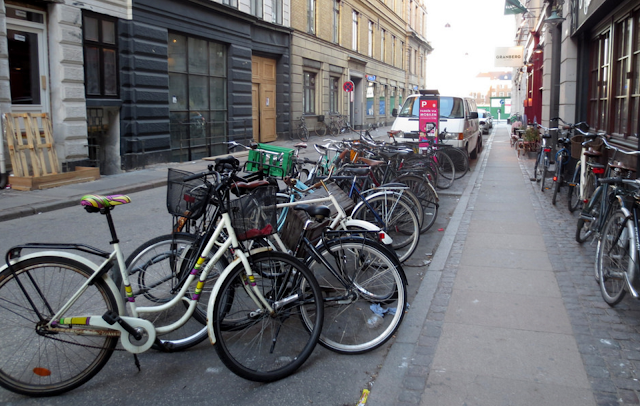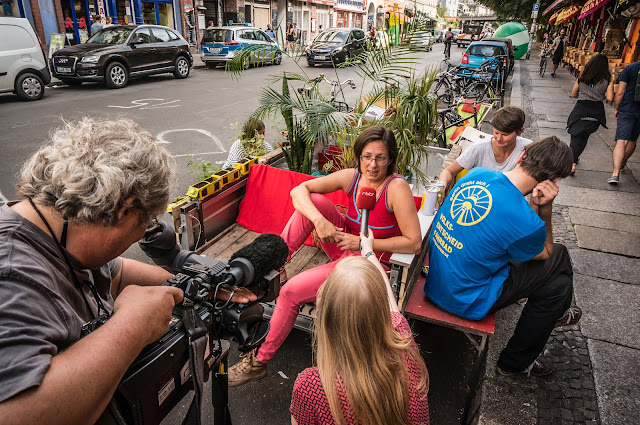
 Dozens of bicycles replace a former single car parking space, a common sight on Copenhagen streets.
Dozens of bicycles replace a former single car parking space, a common sight on Copenhagen streets.
Co-written by Sylvia Green and Copenhagenize Design Co.
The transition from summer to autumn brings life back to our cities, filling schools, offices, busses, cycle tracks, roads, and of course, parking spaces. While it’s exciting to feel the energy brought with this transition, it’s hard not to miss the elephant in the room, the bull in the china shop, the private automobile. One annual autumn event, PARK(ing) Day, has done an incredible job at questioning the dominance of the car in our urban spaces. On the third Friday of each September, PARK(ing) Day has everyday citizens transform street parking into public space of their own design.
PARK(ing) day began in San Francisco in 2005, when Rebar Design decided to convert a metered parking spot into a public park for a period of two hours. Since then, a movement has expanded globally, and now includes installations redefining local spaces to suit political, commercial, playful or aesthetic intentions.
In cities worldwide, car parking takes up a tremendous amount of space, is often heavily subsidized, and, despite the general strategic embrace away from high energy and heavily polluting transportation (ie cars), car parking is still seen to be a right in the eyes of planning officials. Even in bicycle-friendly Copenhagen, despite the low vehicular modal share of 22 percent within the city, there is over 3 square km dedicated to parking vehicles. Much of this is unmetered, all is heavily subsidized.
PARK(ing) day allows everyday people to re-imagine what the tremendous amount of public space could contain if cars were not the dominant force they are, and put their imagination into action. The day is also a part of the broader movement to reclaim space in densely populated city spaces. Many of the installations at this year’s PARK(ing) day event contained bicycle-related components. Here are a few of our favourites, to inspire you for next year’s event.
Berlin, Germany.
In Berlin, two installations nicely brought utilitarian cycling issues to the table. The bicycle advocacy group Volksentscheid Fahrrad redesigned a mobile trailer as a small park for hanging out and discussing the referendum movement, which switched spots regularly. One organizer, Maximillian Nawrath, explained, “I think it will raise awareness amongst citizens about how much space parked cars occupy and what we could use in their place. Additionally, I want to promote the referendum group Volksentscheid Fahrrad, because it's state election time in Berlin and we have to be in the minds of the people on election day! We invited lots of press and will be very present in local media, which is super important!”.
 The second, Netzwerk Fahrradfreundliches Neukölln, set up an installation along Hermannplatz, an arterial characterised by heavy car traffic and very little bicycle infrastructure. There, temporary bicycle parking was created and bicycles were painted on the street to visualize the need for a protected bike lane instead of free parking space for cars. A representative from Netzwerk Fahrradfreundliches Neukölln explained, “[PARK(ing) Day] has relevance generally as many cities are growing and a battle has started over the public space. Cities need to re-think how to use it in the most sustainable and efficient way. Berlin is fast-growing and there is an increase of traffic and parking. Yet, cities and are for people and not for cars. A liveable city focusses on enough recreation zones, and space for traffic participants who do not emit fumes, CO2 and noise.”
The second, Netzwerk Fahrradfreundliches Neukölln, set up an installation along Hermannplatz, an arterial characterised by heavy car traffic and very little bicycle infrastructure. There, temporary bicycle parking was created and bicycles were painted on the street to visualize the need for a protected bike lane instead of free parking space for cars. A representative from Netzwerk Fahrradfreundliches Neukölln explained, “[PARK(ing) Day] has relevance generally as many cities are growing and a battle has started over the public space. Cities need to re-think how to use it in the most sustainable and efficient way. Berlin is fast-growing and there is an increase of traffic and parking. Yet, cities and are for people and not for cars. A liveable city focusses on enough recreation zones, and space for traffic participants who do not emit fumes, CO2 and noise.”
Cambridge, USA
In Cambridge, Massachusetts, The Cambridge Bike Committee replaced car parking with a protected bike lane for PARK(ing) day. Megan, from the committee, explained the concept, “I suggested that instead of 1 spot to TALK about biking, that we take over a whole block to SHOW what biking should feel like and even better if it was a high profile street like Mass Ave in front of the busiest coffee shop, Flour, and employer, Novartis. Ms. Anne Marie jumped on the idea and gave it life within the committee. The amazing Cara Seiderman and Jennifer Lawrence scoped out the blocks on Mass Ave and determined that we could install a popup protected bikeways on BOTH sides of a very busy block! To create the barrier of protection, I suggested that kids paint a wall mural, which they loved. I talked to Katie who runs the summer camp program with Annika's school to see if the kids would be interested and if we could use the paint and she was excited to help make it happen.”
Megan hopes that this bike lane will help to change attitudes towards cycling infrastructure in Cambridge. “When you hear people say that ‘we don't have space’ for biking like The Netherlands, remember this picture and let them know that we do have space, but it's used for storing a car driven by typically 1 person. The Dutch didn't do it overnight - it took protesting moms and an oil crisis to jump start the movement in the 70s. We'll get there, too, but it takes a cocktail of passion, time, behavior change and political will."

Montreal, Canada
Turning to Montreal, our local Copenhagenize office made an installation to show the difference between existing painted lanes in Montreal and physically protected one-way cycle tracks. As Michael Wexler explains, “It is one thing to post articles online and look at maps and plans, but for the average person, whether or not they are used to riding a bicycle, seeing is believing.” Michael believes that pop-up bike lanes can dispel myths surrounding cycle tracks, show their versatility and allow users to understand how it feels to have protected infrastructure. “The event allowed us to put something on the ground and engage with people on and off bikes about how their city's streets should and could be better designed. It also didn't hurt that traffic was jammed up on the street while bikes used our cycle track and totally circumvented the gridlock. PARK(ing) day is a great event to show what is possible with so much of our city space that we allocate to storing giant metal boxes”. Michael believes that PARK(ing) day should be used to push the conversation forward in formal planning spaces, “There is so much potential for good design in a city like Montreal - where there is arguably the strongest urban cycling culture in North America.”

As a fun and engaging annual event, PARK(ing) Day does an excellent job of having everyday citizens draw to light the potential of the inefficient use of these highly valuable spaces. In some cases, such as San Francisco’s Parklet program, the movement has successfully inspired more formal and permanent installations expanding the public realm. Rather than subsidizing valuable urban land to accommodate big metal boxes it’s time for cities to wake up to the misconception of parking as an necessity and economic generator. Here’s to seeing PARK(ing) Day continue to question the status quo of our urban parking spaces.
For more information on organising your own PARK(ing) Day, click here.




